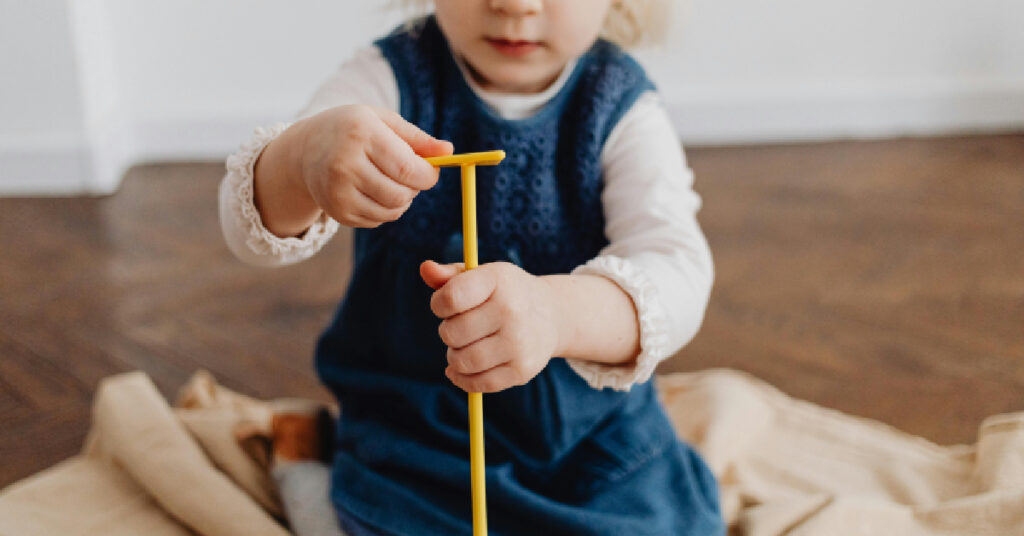
15 Best Toys for Building Independence — That Aren’t Boring or Overhyped
From magnetic tiles to dolls and pretend kitchens, these 15 toddler toys are actually worth the shelf space — and designed to encourage solo play and confidence.
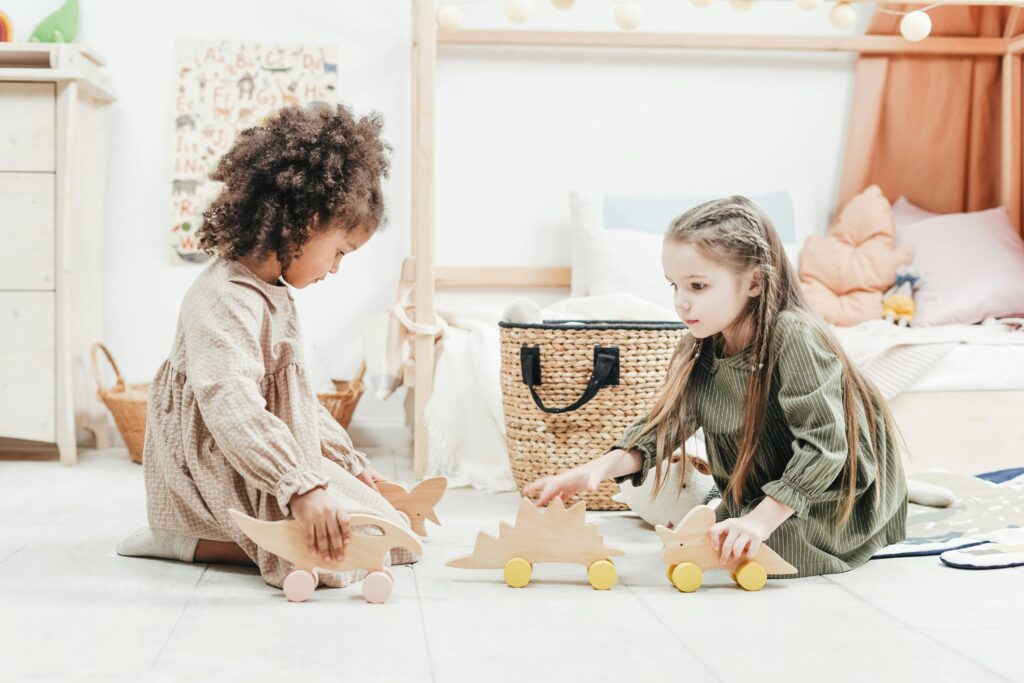
“So… they’re just playing?”
That’s the reaction most of us have the first time we hear the phrase open ended play.
Because when your toddler is making soup out of crayons, talking to a sock, and turning your laundry basket into a rocket ship… it doesn’t look like learning. It looks like chaos.
But here’s the truth:
Those messy, noisy, random moments? They’re doing big work behind the scenes — building your child’s brain, creativity, and emotional resilience in ways that structured activities can’t touch.
This post breaks down exactly what open-ended play is, why it matters, and the real benefits of open ended play for toddlers aged 1 to 5. You’ll get real-mum insight, expert-backed science, and zero pressure to become a Pinterest playroom goddess.
Just clear, powerful info that helps you raise confident, imaginative kids — and maybe sip a hot drink in peace while you’re at it.
Before we dive deep into the benefits of open ended play, let’s get clear on what it actually is — and what it definitely isn’t.
Open ended play is any kind of play that has no fixed outcome, no step-by-step instructions, and no “right” or “wrong” way to do it. It’s all about the process, not the result. The child leads. The toys don’t talk. The story shifts constantly. And the possibilities? Endless.
Read More: Best Open Ended Toys For Toddlers by Age (1–5 Years)
Building with blocks (then smashing them into a “cake” for an imaginary birthday)
Using scarves as rivers, capes, tents, or magic potions
Giving dolls a bath in a salad bowl
Turning a cardboard box into… literally anything – Makedo Explore is our favourite for Cardboard play > Grab yours from amazon
Setting up an animal rescue with pegs, toy lions, and an old sock
There’s no goal, no timer, and no one clapping when they’re done. And that’s exactly the point. It’s child-led, creative, and adaptable — which is why it’s so good for their little brains.
A toy that tells them what to do
Following an adult’s instructions step-by-step
Memorising facts or performing for praise
A perfectly curated setup with rules
It might look like chaos. But neurologically? It’s a goldmine.
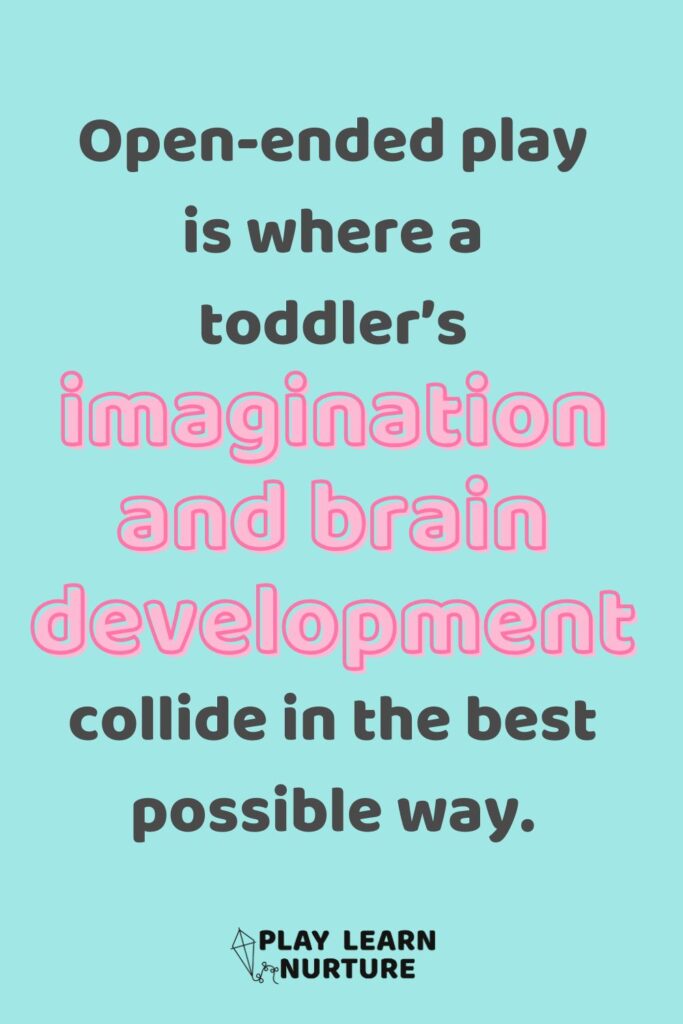
Modern parenting comes with a wild mix of pressure:
✔ Keep your child stimulated
✔ Keep them learning
✔ Keep them screen-free
✔ Keep them happy
✔ And somehow… keep your sanity intact
So it makes sense that so many parents are leaning on structured activities, curated crafts, and educational apps. They’re marketed as “good parenting.”
But here’s the thing: the brain doesn’t always grow best when it’s being directed. Sometimes, the biggest leaps happen when your child is left to lead.
tructured activities have a place, no doubt — but when every moment is adult-led, kids miss out on learning how to think for themselves. They get used to asking “What now?” instead of exploring what could happen next.
Open ended play gives toddlers the opposite experience. It says:
You’re the boss of your play
You decide what happens
You’re allowed to experiment, mess up, and try again
You don’t need praise or permission to keep going
And when they learn that through play? It shows up in how they handle emotions, relationships, schoolwork, risk-taking, problem-solving — you name it.
Play-based learning isn’t just a “nice to have.” The science is clear: open ended play lights up multiple regions of the brain at once.
According to a 2023 article in Psychology Today, play that encourages creativity and freedom helps build neural networks related to memory, self-regulation, and cognitive flexibility. That’s the stuff behind reading, maths, emotional control, and executive function.
Passive screen time
Flashcard drills
Toys that only do one thing
“Sit and listen” moments that dominate formal learning
There’s a time and place for all of it. But nothing replaces the kind of rich, brain-deep wiring that comes from child-led, imaginative play.
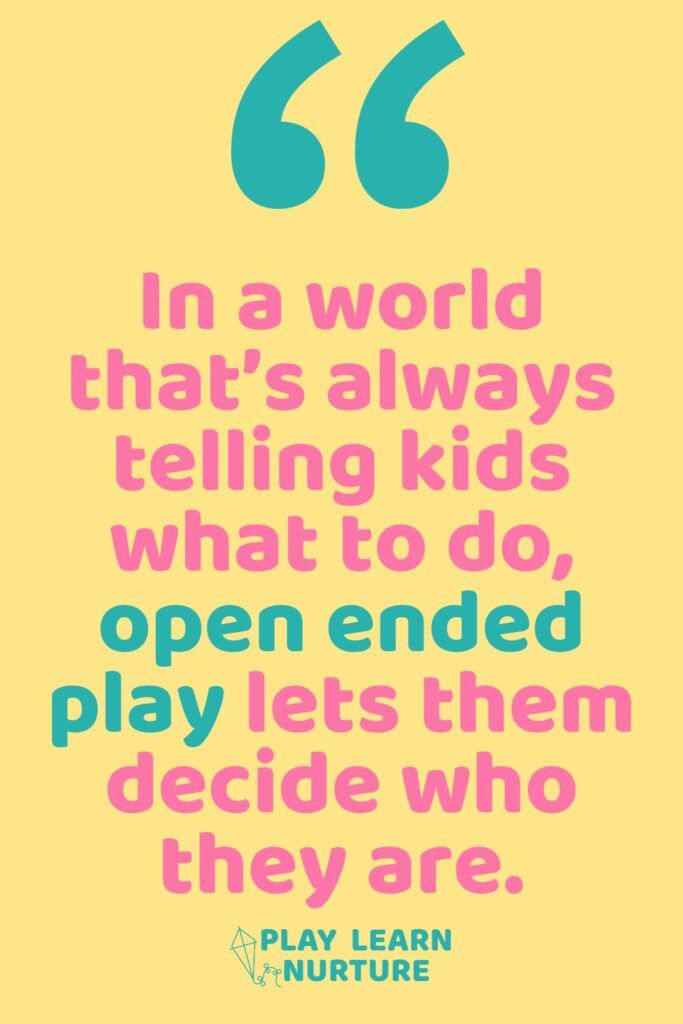
If you’ve ever wished your toddler could entertain themselves for just five freaking minutes, this benefit’s for you.
Open ended play puts your child in charge. No instructions, no “right” way — just space to lead their own story. That kind of autonomy builds real confidence. They learn they can solve problems, make decisions, and explore ideas without needing your constant input.
And that independence? It trickles into everything — getting dressed, managing frustration, even tackling new environments like daycare or kindy.
Real-life moment: Your toddler sets up a “zoo” with soft toys, talks through each animal’s name, builds fences with blocks, and adjusts the layout 10 times — all while you’re folding laundry and sipping (mostly) warm coffee.
Read more: How to Start Independent Play and Finally Enjoy 5 Minutes of Peace
This is the headline-grabber. We know creativity is important — but it’s not just about art. It’s about thinking flexibly, problem solving, and seeing possibilities where others see limitations.
When your toddler uses magnetic tiles to build a spaceship, then turns it into a barn, then lines them up as “tickets” — that’s creativity in action. Open ended play gives them the freedom to invent, switch directions, and create meaning from the materials in front of them.
“Creative play is essential for brain development. It encourages divergent thinking, which is key for innovation,”
Dr. Sandra Russ, psychologist and play researcher at Case Western Reserve University.
Bonus: Open ended play also reduces the pressure on you to constantly provide entertainment. The more they practice creating their own fun, the better they get at it.
Read More: Open Ended Play Made Easy: How to Raise Creative, Confident Kids
Tantrums, frustrations, clinginess — all signs your toddler is working through big feels without all the tools yet. Open ended play gives them a safe space to express, act out, and even rehearse those emotions.
That doll that’s “too sad to eat”? That truck that’s crashing over and over? That’s your child processing emotions through story and symbolism. It’s therapy, toddler-style.
And when they lead that kind of play often, they get better at managing real-life emotions — waiting turns, calming down, and solving small conflicts.
Real-mum moment: Your 3-year-old makes their dinosaur family “argue,” then has them say sorry, hug, and go to bed. You didn’t teach them that — their play did.
Read More: Coming soon – Daily Independent Play Routine That Builds Focus and Confidence
You might not see it right away, but this benefit builds over time. Every time your toddler gets absorbed in block building, peg sorting, or a make-believe camping trip under the table — they’re strengthening their ability to stay focused.
This kind of concentration isn’t forced. It’s self-chosen. That’s why it sticks.
And the more they practice it in open ended play, the more they can use that focus in other settings — like storytime, group activities, or even solo puzzles later on.
This is where the benefits of open ended play really show their long game. Every time your child tries to balance one more block, figure out how to “trap” a toy bear, or decide how to fix a blanket fort collapse — they’re building logic, resilience, and strategy.
And because open ended play has no fixed outcome, every “mistake” is just another part of the story. That’s how they learn to try again without fear of getting it “wrong.”
Real-life moment: Your 4-year-old tries to build a racetrack out of books and cushions. It fails. They try again. It fails again. Then they grab masking tape and try a whole new approach — on their own.
Read More: Coming Soon –Best Loose Parts Toys for Toddlers: Kits That Grow with Your Child
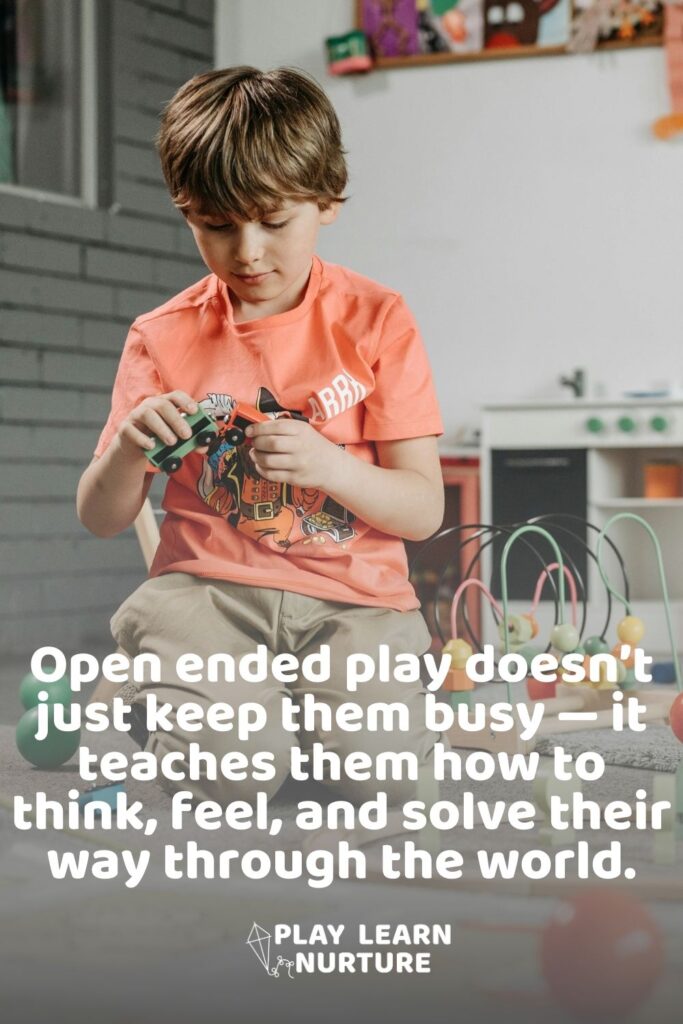
The beauty of open ended play? It grows with your child. What starts as dumping blocks turns into storytelling, strategy, and emotional exploration.
Here’s how the benefits of open ended play show up at different developmental stages — so you know exactly what’s “normal,” what to look for, and how to support it.
Play Style:
Everything is about touch, taste, and movement. Babies and young toddlers explore the world through their senses, so open ended play looks like dumping, banging, mouthing, and crawling through stuff.
Benefits:
Develops sensory integration
Builds motor skills and cause-effect understanding
Lays foundation for confidence through self-led discovery
Example:
Your toddler puts stacking cups on their head, claps them together, and throws them across the room — then claps with joy. Yep, that’s learning.
Play Style:
This is when play starts looking more “pretend.” They’ll feed dolls, drive cars into blanket forts, or bark like a dog while wearing your bra as a hat. You’re officially in Imagination Nation.
Benefits:
Sparks early storytelling and abstract thinking
Supports emotional processing and self-expression
Strengthens memory and repetition-based learning
Example:
They put all the stuffed animals in a laundry basket and call it a “bus.” They drive it around, crash it, and start again. They’re narrating, sequencing, problem-solving — even if they don’t know it.
Play Style:
Your child is now creating entire worlds, stories, and characters. Play may involve multiple steps, roles, and themes. You’re more likely to hear them talking through scenarios (“The baby’s sick! We need to fly to the hospital!”).
Benefits:
Develops sequencing, storytelling, and symbolic play
Expands language and emotional vocabulary
Encourages planning and early executive function skills
Example:
They use blocks to make a castle, put animals in it, and create an entire plot about the king getting stuck in the “lava floor.” That’s critical thinking + fantasy + structure all rolled into play.
Play Style:
Older pre-schoolers start inviting others into their play. You’ll see negotiation, compromise, and a lot of “No, you’re the baby, I’m the mama!” as they assign roles.
Benefits:
Enhances social awareness and empathy
Reinforces complex language and cooperative communication
Teaches leadership, compromise, and perspective-taking
Example:
They gather pillows to make a “pet hotel,” take turns checking animals in, role-play the receptionist, and even argue over who’s in charge. They’re learning so much — and working through social dynamics in the safest space: play.
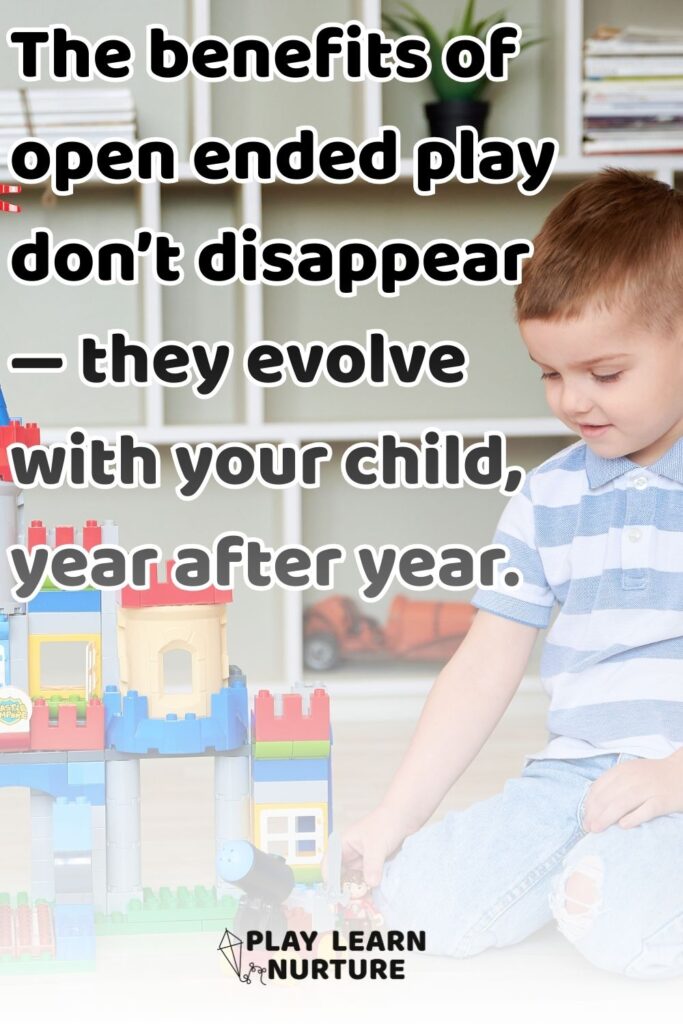
For something so natural, open ended play gets a lot of weird judgment. Some parents feel like it’s not “real” learning. Others think it’s lazy parenting. Let’s clear that noise right up.
Here are the biggest myths — and the real truths behind them.
This is probably the biggest one. And it’s flat-out wrong.
Truth:
Open ended play is foundational learning. It strengthens the brain in areas responsible for attention span, language, emotional regulation, problem solving, and creativity. Kids don’t need worksheets to learn — they need freedom to think for themselves.
Read More: Emotional regulation, executive function, creativity
Read More: The Science Behind Open Ended Play and Brain Development
This one’s relatable. Lots of toddlers want you to watch, comment, or play along.
Truth:
That’s okay — especially in the beginning. But with time, space, and a little practice, kids will begin to take the lead. You can support from the sidelines, gradually giving them more space to direct things on their own.
Read More: How to Start Independent Play and Finally Enjoy 5 Minutes of Peace
You don’t need a chilled-out mini artist for this to work.
Truth:
Every child benefits from open ended play — loud ones, busy ones, anxious ones, wild ones. For high-energy kids, open ended play can actually help regulate their systems and give them an outlet for expression.
Read More: Emotional regulation, confidence, problem solving
Instagram lies. You don’t need a Montessori setup or wooden rainbow shelves.
Truth:
The best tools for open ended play are often the simplest: blocks, scarves, cardboard boxes, pegs, stuffed animals, spoons. If it doesn’t tell your child what to do — it works.
Read More: Coming soon – Minimalist Toy Guide: Essentials for Open Ended Play
Boredom feels uncomfortable for us, so we rush in. But that’s where play magic starts.
Truth:
That first “I’m bored” moment? It’s your child’s brain reaching for an idea. Don’t squash it. Open ended play thrives on boredom — that’s where creativity kicks in.
Read More: Coming soon – Daily Independent Play Routine That Builds Focus and Confidence
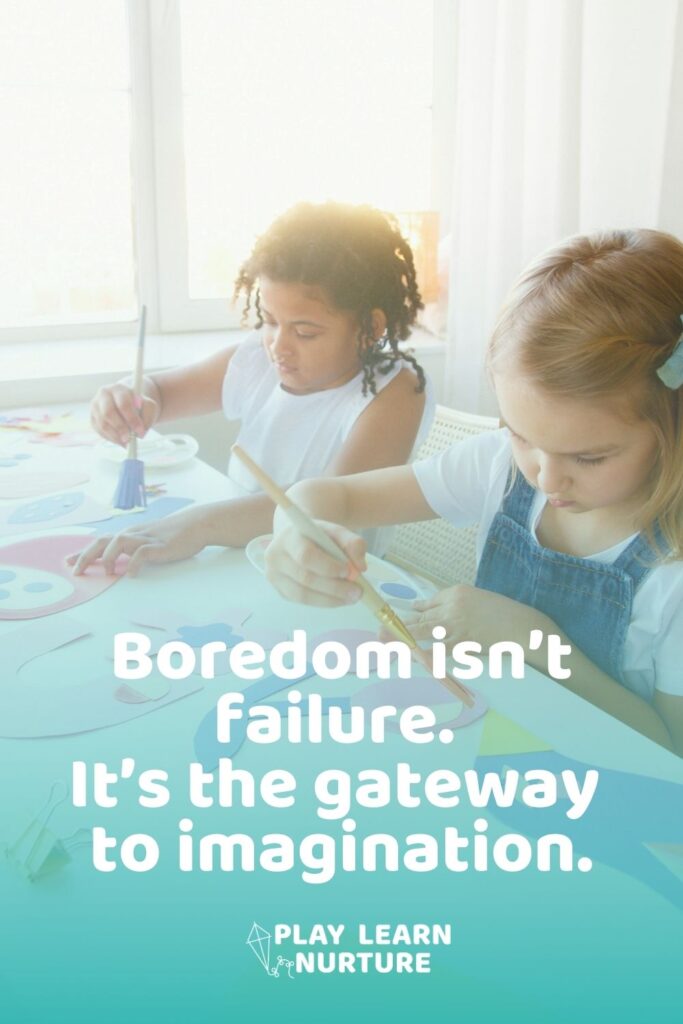
Open ended play supports brain development, emotional regulation, creativity, confidence, and focus in toddlers. It gives children the freedom to explore, problem solve, and build independence without adult-led structure. It also boosts imagination and storytelling skills that contribute to early language development.
Open ended play activates multiple regions of the brain at once. It strengthens connections related to executive function (like planning, focus, and impulse control), emotional regulation, and problem solving. By choosing their own actions and outcomes, children develop stronger neural pathways that support future academic and life skills.
Read More: The Science Behind Open Ended Play and Brain Development
Open ended play has no specific goal or rules. It allows the child to lead, create, and change the direction of play at any time. Structured play has a clear beginning, middle, and end — like puzzles, games, or adult-led activities. Both are valuable, but open ended play promotes more flexible thinking and independence.
Yes! Encouraging open ended play can reduce screen reliance by giving your child something equally engaging — but better for their brain. When kids get used to playing independently with open-ended toys, they often need less passive entertainment.
Simple is best. Magnetic tiles, blocks, dolls, animals, loose parts (like pegs, lids, scarves), play silks, cardboard boxes, and cars are all brilliant for open ended play. If the toy doesn’t talk or tell them what to do — it’s probably perfect.
Read More: Coming Soon – Minimalist Toy Guide: Essentials for Open Ended Play
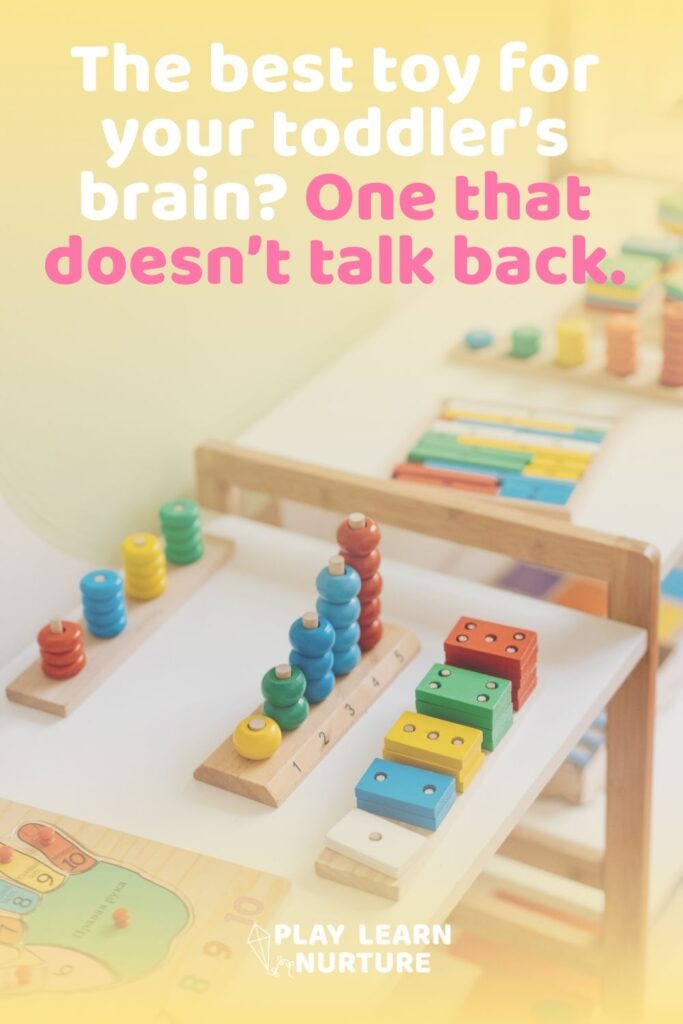
You don’t need a Montessori certification or a Pinterest-worthy playroom to support open ended play. Honestly? Most of what your toddler needs is already in your house — and what they don’t need is adult over-involvement.
Here’s how to create a home environment that quietly invites the benefits of open ended play, day after day.
Toddlers don’t need 84 toys in one room. In fact, too many choices can kill their ability to focus.
Try this:
Keep 5–6 open ended toys out at a time
Rotate weekly or fortnightly
Use baskets or open shelves at their height
Read More: Coming Soon – How to Set Up an Independent Play Corner (Even in Small Spaces)
Skip the flashing lights and talking plastic. The best toys are the ones that let your child decide what they become.
Open ended toy ideas:
Magnetic tiles
Blocks (wooden or plastic)
Dolls and figurines
Loose parts (spoons, lids, cups, pegs)
Play silks, scarves, or fabric scraps
Toy animals, cars, and everyday objects
Read More: Coming Soon – Minimalist Toy Guide: Essentials for Open Ended Play
One of the easiest ways to see the benefits of open ended play is to make it part of your routine, not just something you do “when you have time.”
Try this:
Set a time after snack or before nap each day
Call it “playtime” or “imagination station”
Start with 10–15 minutes, then slowly stretch it
Read More: Coming Soon – Daily Independent Play Routine That Builds Focus and Confidence
Your child might want you close at first — and that’s fine. You can sit on the couch, fold laundry, or sip your drink. The key is not to direct, correct, or question their play. Let them be in charge.
Pro tip:
If they invite you in, follow their lead. Become the assistant, not the director.
That “I’m bored!” moment is where creativity starts. Let them sit in it. You don’t have to fix it or entertain them. The idea will come.
Because here’s the truth:
Boredom is the doorway to imagination — not a problem to solve.
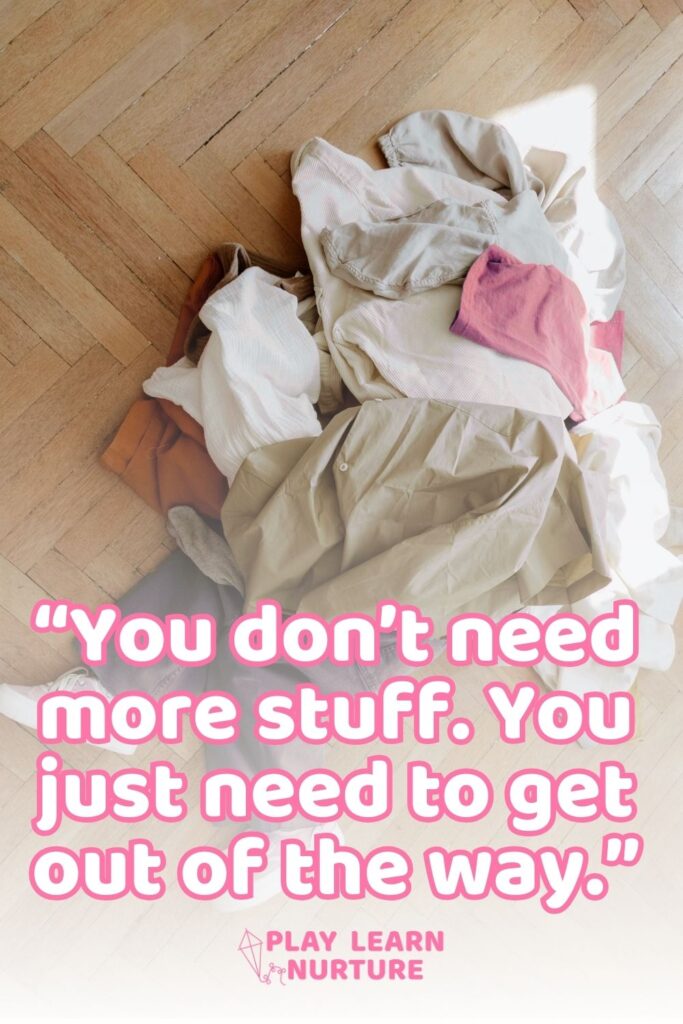
You don’t need fancy toys. You don’t need to entertain your child all day. And you definitely don’t need to feel guilty for saying, “Go play.”
Because when you make space for open ended play, you’re giving your child something bigger than a quick distraction. You’re giving them the freedom to imagine, create, problem-solve, lead, focus, and feel — all on their own terms.
That’s not “just play.” That’s developmental gold.
And the best part? You’re probably already doing more than you realise. Every time you resist stepping in, every time you offer a box instead of a battery-operated toy, every time you let the play get messy — you’re nurturing the benefits of open ended play in a way that will stick with your child for life.
So here’s your real-mum permission slip:
Let them lead.
Step back a little.
Watch the magic happen.
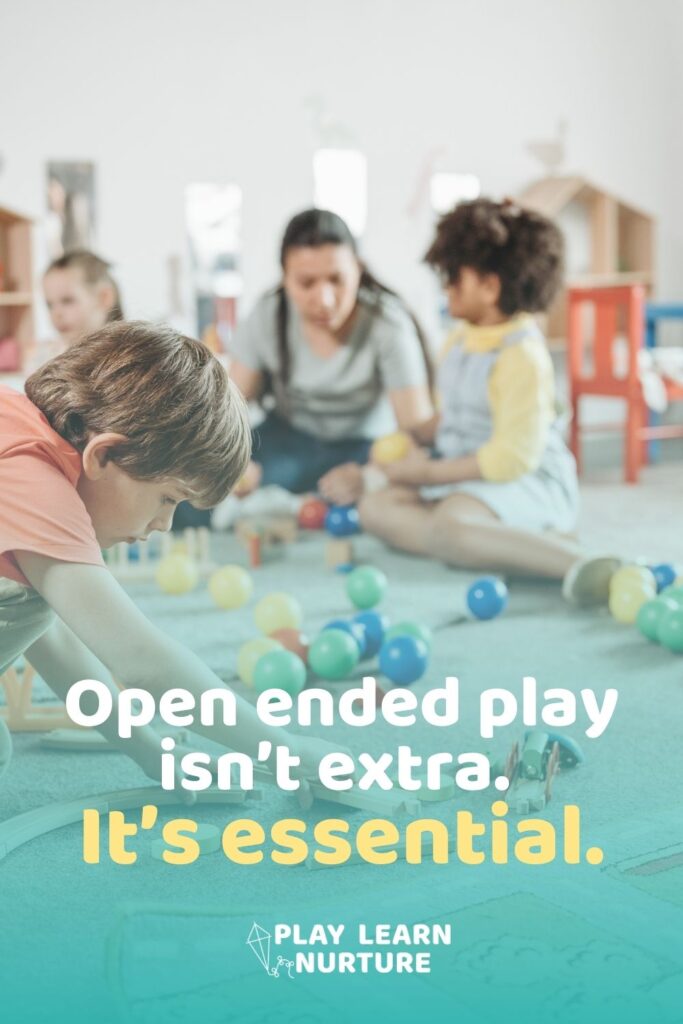

From magnetic tiles to dolls and pretend kitchens, these 15 toddler toys are actually worth the shelf space — and designed to encourage solo play and confidence.
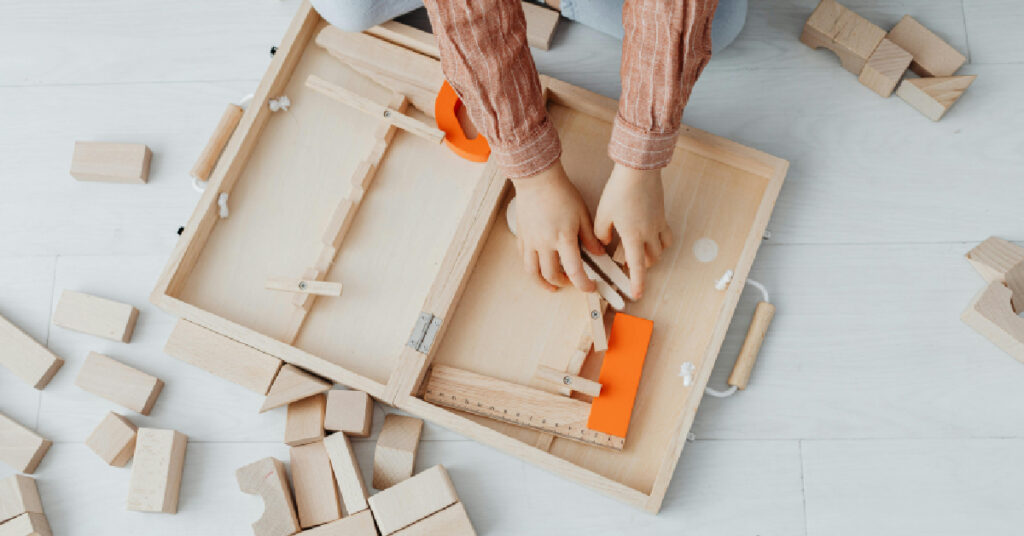
Delve into the world of loose parts play with our selection of toys that inspire exploration and innovation. Perfect for enhancing your toddler’s sensory and cognitive skills.
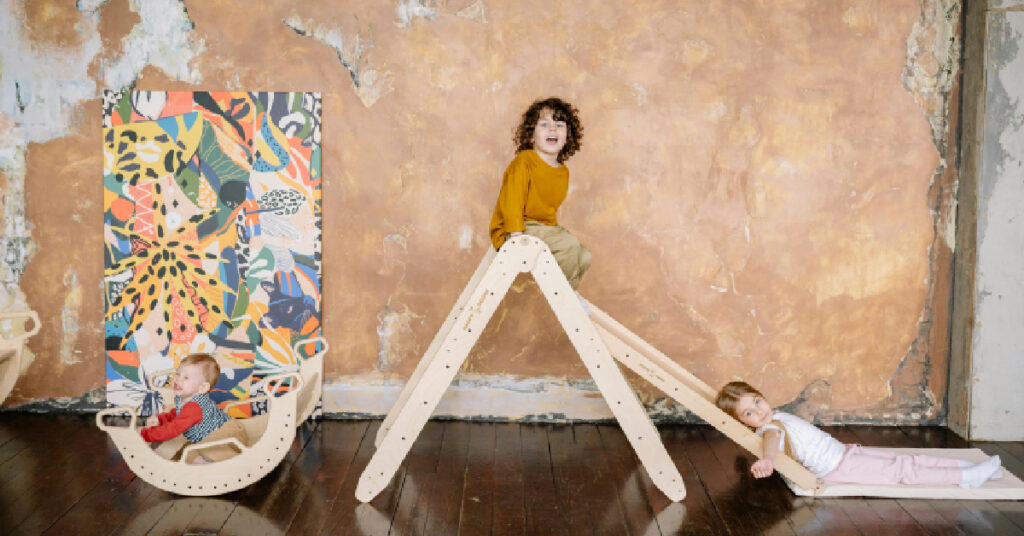
Simple, real-life play space ideas for toddlers that spark imagination, support independence, and give you a moment to breathe — no Pinterest-perfect setup required.
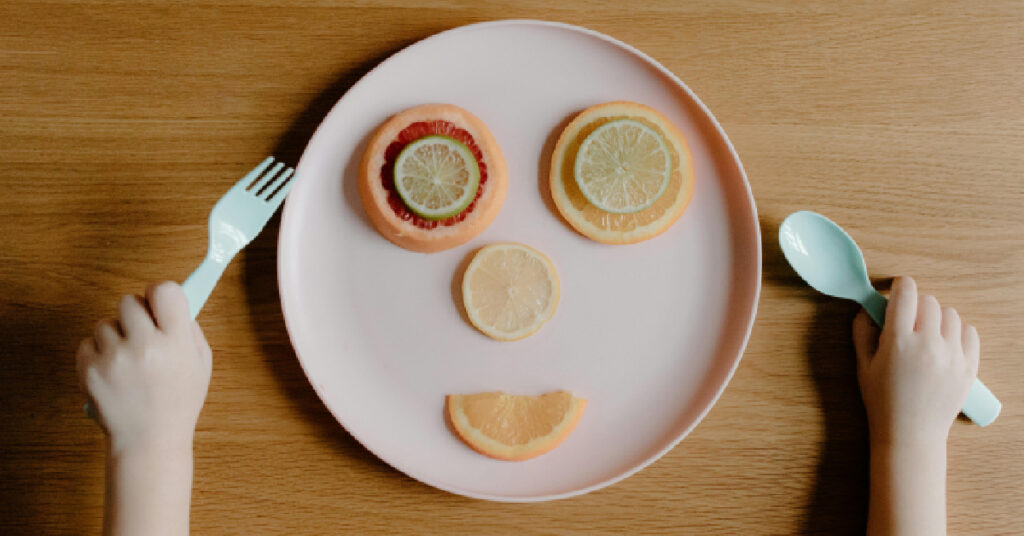
When the milk spills, the toddler tantrums, and your patience snaps before 9AM — you’re not failing. This is one mum’s story of surviving the messy mornings and finding connection in the chaos.
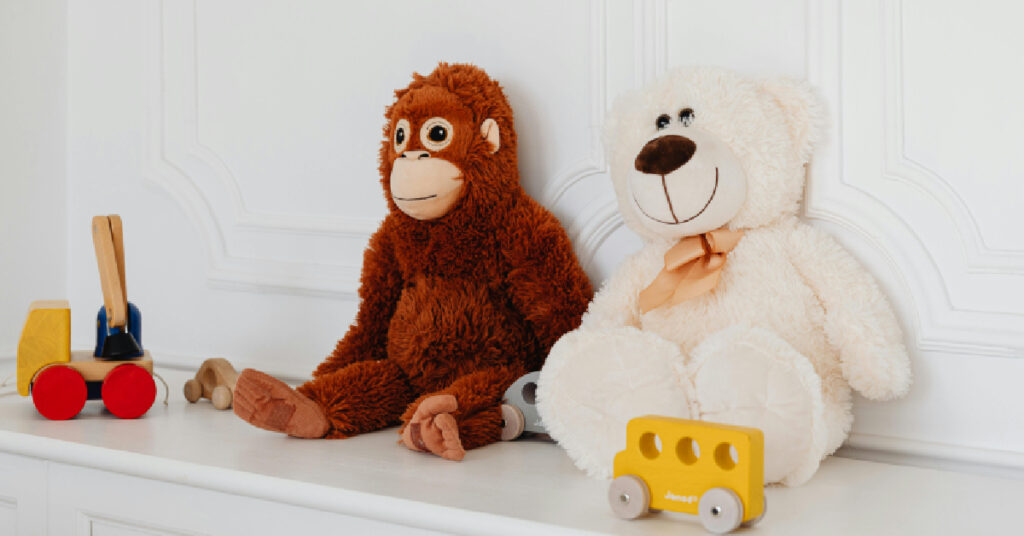
Discover how a simple toddler play schedule can create calmer days, boost independent play, and give you back precious breathing space — no strict routines required.

One chaotic morning, I realised the tension in the house wasn’t just coming from my toddler — it was coming from me. This is the story of how I stopped fuelling the chaos and started checking my own emotional thermostat first.